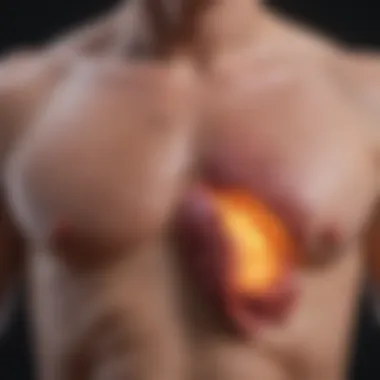Cirrhosis and Its Impact on Skin Health


Intro
Cirrhosis, a chronic liver condition, can significantly affect the body in various ways, with skin manifestations often being one of the more visually apparent symptoms. While the liver itself usually operates quietly behind the scenes, its decline and eventual scarring can bring about changes that tug at the surface. These changes may seem purely cosmetic at first glance, but they are indicative of deeper physiological disturbances. This interplay between liver health and skin appearance warrants substantial exploration, not only to recognize these symptoms but also to understand their implications.
Understanding how cirrhosis affects the skin can guide healthcare professionals and informed individuals alike in recognizing early signs that might otherwise go unnoticed. Skin rashes, discoloration, and other skin-related issues can be important indicators of the liver’s health status. The complexity of these signs calls for a detailed examination of how liver dysfunction translates into dermatological manifestations.
As we dissect various types of rashes linked to liver damage and the underlying mechanisms that drive them, it's vital to appreciate the clinical presentation of these conditions. Furthermore, this article will offer insights on researching and managing such skin manifestations, ensuring that individuals understand both prevention strategies and treatment options available.
Equally importantly, this discourse is enriched by recent advances in medical understanding, leading to enhanced diagnostics and innovative treatment strategies. Not merely an exploration of skin health, but a comprehensive guide for those affected by or interested in the complex relationships engendered by cirrhosis.
Foreword to Cirrhosis
Cirrhosis stands as a major player in the arena of liver diseases, representing the culmination of various forms of liver damage. This topic is not merely an academic exercise; understanding cirrhosis is crucial for both health professionals and the wider public. The implications stretch far beyond just liver health, resonating through numerous bodily systems and particularly impacting the skin.
Importance of Understanding Cirrhosis
When we delve into cirrhosis, we’re not only recognizing a disease but an intricate tapestry of symptoms, causes, and effects. The liver performs vital functions: processing nutrients, producing bile, and detoxifying harmful substances. Once cirrhosis sets in, these functions deteriorate over time, leading to significant health consequences.
Considering skin manifestations can be particularly eye-opening. Skin changes often act as glaring signals, hinting at underlying liver troubles. From the characteristic rashes to itchiness, these signs provide critical insights into the body's overall condition. Notably, they herald the need for further investigation, facilitating early diagnosis and potential intervention.
In this article, we will break down cirrhosis, exploring its definition and causes, while paying special attention to how it manifests on the skin. With a clear understanding of these aspects, individuals and healthcare providers can take informed steps to address and manage this challenging disease.
Cirrhosis and Skin Manifestations
The connection between cirrhosis and its impact on skin health cannot be overstated. As the liver deteriorates, various changes emerge that extend far beyond just physiological or metabolic markers; they resonate visibly through the skin. When it comes down to it, skin manifestations are often the most noticeable signs indicating that something is going awry internally. By recognizing these symptoms, both patients and healthcare providers can take early steps in managing the disease effectively.
Understanding these links is crucial because skin changes can serve as valuable indicators of the underlying severity of liver damage. As we peel back the layers, several common skin issues arise, including rashes and discoloration, which reflect the distress signals from the liver. This article aims to shed light on how these manifestations arise, the details surrounding their characteristics, and ultimately, why they’re significant in the broader context of cirrhosis management.
Understanding Skin Changes
When liver function is compromised, the skin often tells a story that warrants immediate attention. The body undergoes a cascade of pathophysiological transformations that not only affect internal processes but also show up on the skin. One major point to note is that changes like temperature variations and altered pigmentation can be early signs that something is amiss.
Through various alterations in circulation, skin permeability, and immune responses, skin changes can range from mild irritations to severe complications. Understanding these changes can help in identifying issues sooner, allowing for timely treatments that could, at the very least, ease discomfort and improve the quality of life.
Common Skin Rashes Associated with Cirrhosis
Spider angiomas
One significant skin manifestation is spider angiomas, which are small, red clusters resembling spider webs. These vascular lesions tend to appear on the face, neck, and arms and can be more pronounced in individuals with severe liver dysfunction. The presence of spider angiomas often indicates increased estrogen levels due to the liver's inability to metabolize hormones effectively.
They are not harmful themselves but act as a visual marker for liver health. Patients displaying multiple spider angiomas may require comprehensive liver assessment, making them a beneficial inclusion in any discussion about cirrhosis and its skin implications.
Palmar erythema
Another notable skin change is palmar erythema, characterized by reddening of the palms. This condition arises from increased blood flow and can be a strong indicator of chronic liver damage. It’s often more noticeable at the tips of the fingers, and it’s not uncommon for patients to feel embarrassed by its appearance.
Despite the cosmetic challenge it presents, palmar erythema provides essential information regarding liver function and systemic circulation. Recognizing this manifestation can prompt further exploration of liver health, making it a valuable entry point in discussions about liver conditions.
Xanthelasma
Then come the xanthelasma, which present as yellowish plaques that commonly form around the eyelids. While these growths are mostly benign, they may signify elevated cholesterol levels often associated with cirrhosis. Xanthelasma serve as visual indicators that the body is in distress, signaling to both patients and doctors that further investigation is needed.


People dealing with xanthelasma can face both physical and psychological challenges; understanding the link between these lesions and liver health is pivotal, enhancing awareness around nutrition and metabolic management.
Pruritus
Lastly, pruritus, or severe itching, often stems from bile salt accumulation due to impaired liver function. This symptom can significantly affect the quality of life, causing widespread discomfort. Pruritus serves as a clue that the liver is not functioning properly, and while it does not have visible characteristics like rashes, the heightened itchiness resonates deeply affecting daily activities.
Recognizing pruritus can lead to interventions aimed at improving liver function or at least alleviating the associated discomfort, underscoring its importance in the dialogue about cirrhosis.
Mechanisms Behind Skin Rashes
Changes in blood flow
Blood flow alterations play a pivotal role in the changes noted at the skin’s surface. Hepatic dysfunction can lead to increased blood vessels' dilation, causing conditions like spider angiomas and palmar erythema. This change might seem purely aesthetic, but it often hints at profound internal issues, necessitating further metabolic evaluation and potentially impacting treatment options.
Metabolic disturbances
Metabolic disturbances due to cirrhosis also contribute to skin manifestations. The liver’s compromised ability to process fats and hormones can lead to abnormal skin conditions. Xanthelasma are a prime example where altered fat metabolism results in lipid accumulation, demonstrating just how interconnected our bodily systems are. Addressing the underlying metabolic issues can significantly relieve the patients from symptoms while managing their cirrhosis.
Immune system alterations
Lastly, changes within the immune system can trigger skin issues as well. In cirrhosis, the liver’s role in middleware for immune responses can be diminished. This dysfunction may increase susceptibility to skin infections or lead to the development of skin lesions. Acknowledging these immune changes gives insight into how to approach treatments holistically while enhancing patient education on skin care.
Both skin manifestations and their underlying mechanisms deserve keen attention, as they unravel a significant part of the liver’s overall impact on health. Understanding this intricacy can pave the way for improved management strategies.
Diagnosing Cirrhosis and its Symptoms
Understanding how to diagnose cirrhosis is crucial for early intervention and effective management of the condition. Not only does cirrhosis present several challenges for liver function, but it also showcases specific symptoms that can significantly impact the patient’s quality of life. Identifying these symptoms early can lead to timely treatment and potentially halt the progression of liver disease.
Clinical Presentation
Symptom assessment
Symptom assessment provides a framework to gauge the overall health status of individuals suspected of having cirrhosis. Not only does it permit healthcare professionals to identify the presence of liver-related symptoms, but it also allows for a comprehensive understanding of how these symptoms affect daily functioning. A key characteristic of symptom assessment is its ability to prioritize symptoms often associated with dysfunction, such as fatigue, jaundice, or swelling. Its significance lies in identifying those symptoms that can be addressed immediately, improving the patient's life quality.
One unique feature of this approach is that it can show trends in symptom progression over time. By using validated questionnaires or self-reporting tools, patients and clinicians can observe how symptoms evolve, which can be beneficial in tailoring treatment strategies.
However, the subjective nature of symptom assessment can pose some challenges. Patients may underreport or misinterpret their symptoms, creating a potential gap in accurate diagnosis. Being aware of this, healthcare providers often combine symptom assessment with more objective diagnostic tests to create a fuller picture of liver health.
Physical examination findings
A physical examination serves as another vital element in the diagnostic puzzle when it comes to cirrhosis. Through this process, clinicians can identify physical signs, such as abdominal swelling or liver enlargement, associated with liver dysfunction. It often includes checking for signs like spider angiomas or palmar erythema, which might signal underlying cirrhosis. A notable aspect of physical examinations is their direct interaction with the patient, allowing for rapport building while gathering critical information.
The distinctive feature of a thorough physical examination is that it combines both visual assessment and palpation, thus unveiling potential manifestations directly linked to liver disease. This hands-on approach can make it a beneficial choice in diagnosing cirrhosis as it provides immediate feedback based on clinical observations.
Nevertheless, physical examination findings are sometimes limited by patient compliance or the clinician's experience level. Relying solely on physical signs can lead to missed diagnoses, particularly in early-stage cirrhosis when signs may not be as apparent.
Diagnostic Tests
Liver function tests
Liver function tests are pivotal in diagnosing cirrhosis and monitoring its progression over time. These tests measure levels of various enzymes and substances within the liver, offering insight into its functional capacity. Abnormal results can indicate liver inflammation or damage, informing the healthcare provider about the severity of cirrhosis. This objective measurement is a cornerstone when correlating clinical presentation with actual liver condition.
The key characteristic of liver function tests is their non-invasive nature, which makes them a popular choice among healthcare providers. They can be easily performed during routine blood work, ensuring accessibility to a broader patient population.


Unique to liver function tests is the ability to track changes over time, enabling clinicians to adjust treatment based on patients’ responses. However, a significant drawback is that abnormal results do not exclusively indicate cirrhosis. Other liver diseases might also produce similar changes, creating a potential for misinterpretation.
Imaging techniques
Imaging techniques play a crucial role in diagnosing cirrhosis. They provide detailed visuals of the liver, which can reveal structural changes like fibrosis or tumors. Techniques such as ultrasound, CT scans, or MRIs offer a non-invasive look inside the body, aiding in confirming a diagnosis that symptom assessments and blood tests suggest. A primary advantage of imaging is its capability to identify complications arising from cirrhosis, such as ascites or varices, often requiring immediate medical attention.
What sets imaging techniques apart is their potential to assess liver architecture thoroughly. They can identify not only damage from cirrhosis but other liver conditions that might mimic it. However, one downside is that imaging can be expensive and might not always be readily available in every healthcare setting.
Liver biopsy
A liver biopsy is considered the gold standard for diagnosing cirrhosis, allowing for direct examination of liver tissue. Through this procedure, pathologists can determine the extent of fibrosis and thus classify the stage of cirrhosis accurately. It is a definitive test that provides real insight into the severity of liver damage, which is crucial for treatment planning.
The defining characteristic of a liver biopsy is the level of detail it offers regarding the liver's cellular changes over time. By evaluating liver tissue, clinicians gain insights that other diagnostic methods cannot provide, leading to well-informed decisions.
Despite these advantages, liver biopsy comes with risks including bleeding or infection, making it a less desirable option for some patients. Moreover, the need for sedation or anesthesia can further complicate the procedure. Thus, while it remains an invaluable tool, it is often reserved for cases where the diagnosis remains uncertain after less invasive methods are employed.
Management of Cirrhosis and Related Skin Issues
Management of cirrhosis extends beyond the liver itself, having profound implications for the skin. It's crucial to recognize how liver dysfunction triggers distinct skin manifestations and to approach management holistically. Not only do these skin symptoms affect quality of life, but they can also signal underlying medical issues.
By tackling skin issues associated with cirrhosis, the aim is not just about cosmetic improvement, but also about enhancing overall well-being. Embracing effective management strategies can alleviate discomfort, reduce complications, and ultimately provide a path forward for patients.
Treatment Options for Cirrhosis
Medication management
Medication management often forms the cornerstone of treatment for cirrhosis and related skin issues. Prescribed drugs can effectively alleviate symptoms and prevent further liver deterioration. A key characteristic of this approach is that it tailors pharmacological interventions to individual needs. For instance, diuretics are commonly used to control fluid retention while antihistamines can help manage itching resultant from liver conditions.
The unique feature of medication management is its ability to target specific symptoms while considering the patient’s overall health profile. It's a widely accepted method due to its targeted benefits, but it does come with possible limitations, including side effects or contraindications that need careful monitoring
Lifestyle modifications
Lifestyle modifications play a significant role in managing cirrhosis. These adaptations can have lasting effects on liver health and skin appearance. Key characteristics include dietary alterations, increased physical activity, and abstaining from alcohol. For example, adhering to a low-sodium diet can help mitigate fluid retention issues.
What makes lifestyle modifications beneficial is their holistic nature; they empower patients to take control of their health. However, some may find drastic changes difficult. Support and guidance can make this journey smoother.
Surgical interventions
In more severe cases of cirrhosis, surgical interventions might become necessary. These can range from variceal band ligation in cases of portal hypertension to liver transplantation for end-stage liver disease. The key characteristic of surgical interventions is their ability to dramatically alleviate pressure on the liver and other organs.
Such interventions are deemed beneficial for patients with complex liver dysfunction, providing them with a new lease on life. Nevertheless, they come with their risks. Both the surgical procedure and post-operative recoveries need to be managed closely to ensure the best outcomes.
Addressing Skin Symptoms
Topical treatments
Topical treatments represent an immediate line of defense against skin issues related to cirrhosis. These can include corticosteroid creams for rashes or moisturizing ointments for dry skin. The key aspect of topical therapies is their straightforward application and targeted action at the affected area.
The unique feature of topical treatments is that they provide symptomatic relief rapidly. They are generally well-tolerated but their scope is limited; if the underlying liver condition worsens, topical solutions may no longer suffice.
Phototherapy


Phototherapy has emerged as an innovative option for some skin manifestations stemming from cirrhosis. This treatment utilizes specific wavelengths of light to reduce inflammation and discomfort. A key characteristic of phototherapy is its ability to work on a cellular level.
This approach can be quite beneficial, offering reduction in symptoms for conditions like xerosis or pruritus. However, access to specialized equipment may be a downside to some patients due to cost or location.
Patient education
Patient education is integral to effective management of cirrhosis and its skin manifestations. Providing patients with information about their condition, possible symptoms, and self-care can empower them to take charge of their health. A key characteristic here is fostering understanding to prevent complications.
By equipping individuals with knowledge, they can better manage their symptoms. However, information overload can lead to confusion; hence, concise and clear communication is essential.
"Understanding the skin manifestations associated with cirrhosis isn't just about identifying rashes. It also involves recognizing how liver health impacts overall wellness."
Prevention and Lifestyle Considerations
Understanding cirrhosis and its impact on skin manifestations goes beyond just recognizing the symptoms. It has a significant connection to prevention and lifestyle choices, playing a critical role in either mitigating or advancing the condition. Adopting a preventative mindset can steer individuals away from the perilous shores of liver disease and skin complications. Prevention isn’t just about avoiding cirrhosis; it’s also about maintaining skin health and ensuring a holistic approach to well-being.
Preventing Cirrhosis
The first step to taking charge is being aware of the primary causes of cirrhosis. Avoiding excessive alcohol consumption is crucial; moderation can save your liver from undue stress and damage. In tandem, prioritizing regular check-ups for hepatitis or other liver infections should be non-negotiable for anyone at risk. A healthy lifestyle isn’t just a buzzword. Maintaining a balanced diet rich in fiber, fruits, and vegetables supports liver health and keeps the chances of developing non-alcoholic fatty liver disease at a minimum. Lifestyle choices, like engaging in regular physical activity and steering clear of illicit drugs, can also go a long way in safeguarding the liver.
Supporting Skin Health
Nutrition and hydration
The role of nutrition and hydration cannot be overstated in the maintenance of skin health, especially for individuals dealing with cirrhosis. A well-rounded diet, rich in antioxidants, vitamins, and minerals, plays a pivotal role in skin and liver health. For instance, leafy greens and berries are not just good for general health; they also support the liver’s detoxification processes. Staying well-hydrated helps maintain skin elasticity and promotes the overall function of metabolic processes. The characteristic feature of hydration is that it’s not often considered, yet its benefits for the skin and the liver cannot be overlooked—it helps to flush out toxins. However, extreme emphasis on over-hydration without understanding individual health needs might lead to complications, especially in patients with severe liver dysfunction, necessitating care and attention.
Skincare routines
Alongside nutrition, establishing effective skincare routines is essential for individuals with cirrhosis. Simple routines encompassing cleansing and moisturizing can boost skin health while countering the dryness often seen with liver disease. Individuals should consider products that are gentle and free of harsh chemicals. The beauty of a good skincare routine lies in its consistency rather than complexity. Such routines can significantly enhance skin hydration and rejuvenation. While establishing these routines is vital, it’s important to recognize the uniqueness in skin types and the way liver conditions might affect them. Not every product suits everyone; thus, vigilance in product selection is paramount.
Monitoring skin changes
Being proactive in monitoring skin changes is a critical aspect of managing health for those with cirrhosis. A keen eye for unusual rashes, discolorations, or lesions becomes essential. Early detection can help address any complications before they escalate. Regularly evaluating the skin also fosters a stronger connection between the individual and their health, setting the stage for better treatment outcomes. The key characteristic here is awareness; understanding the subtle changes might save individuals from more significant health concerns down the line. That said, while vigilance is important, it should not spiral into unnecessary anxiety. Finding a balance is essential.
“An ounce of prevention is worth a pound of cure.”
When it comes to cirrhosis and skin health, this old adage rings truer than ever. Lifestyle adjustments tailored to liver health benefit not only the liver but also enhance the vitality of the skin. Recognizing the connections between prevention, lifestyle, and health pays rich dividends on the road to maintaining a better quality of life.
Closure
Cirrhosis is more than just a liver condition; it paints a broader picture of how intertwined our bodily systems are, extending its impact far beyond what one might initially think. The skin, as our body’s largest organ, serves as a canvas showing the effects of this disease. Recognizing the skin manifestations helps in identifying complications early on. This is crucial because timely intervention might steer a patient's trajectory more favorably.
The potential skin changes related to cirrhosis, such as spider angiomas and palmar erythema, are not merely superficial. They can indicate deeper, systemic issues that may require immediate attention.
When discussing this topic, key elements emerge:
- Awareness: Understanding how cirrhosis affects skin health is the first step. Patients and healthcare providers alike need to pay close attention to these signals.
- Diagnosis and Treatment: Correctly identifying the skin symptoms can lead to more precise assessments. This, in turn, bespoke treatment plans that might enhance a patient’s quality of life.
- Holistic Approach: Treating cirrhosis is multifaceted. Lifestyle changes, regular monitoring, and symptom management contribute to a comprehensive care strategy.
Not the least of which is the benefit of educating patients. Knowledge of what to look out for can empower individuals. It gives them tools to advocate for their health effectively.
In a nutshell, understanding the relation between cirrhosis and skin manifestations isn't just a matter of academic interest; it’s a practical consideration that could enhance clinical outcomes.
"The skin often tells stories of what lies beneath. Listen closely to understand the implications of cirrhosis."
Summary of Key Points
- Skin symptoms as indicators: Skin changes offer insights into the progression of cirrhosis and overall liver health.
- Impacts on the quality of life: Addressing both liver health and skin condition can lead to increased well-being and comfort.
- Ongoing education: Equipping both patients and healthcare providers with knowledge about cirrhosis can facilitate better management strategies.
Addressing cirrhosis comprehensively means considering its diverse manifestations. Each aspect, including skin health, plays a pivotal role in the patient's journey.















